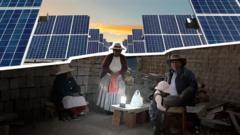Residents of Pampa Clemesí, a small settlement in southern Peru, rely on flashlights to illuminate their surroundings each night, despite living mere meters from the Rubí solar complex, the country’s largest solar power installation. Rosa Chamami's mornings often begin with her cooking on a makeshift stove fueled by discarded cardboard boxes previously used to transport solar panels. The Rubí and Clemesí solar plants, operational since 2018, produce enough energy to power 351,000 households, while the village’s 150 residents remain entirely disconnected from the national grid.
The irony of the situation is glaring. Pampa Clemesí is surrounded by the stark glow of solar panels, yet the community struggles to access the energy that surrounds them. Although a few houses have received solar panels from the plant’s operator, Orygen, the high costs of battery storage and converters leave most residents in the dark. Nighttime means navigating by torchlight for families who feel the deepest effects of energy inequality.
In Peru, the push for renewables is at an all-time high, though experts argue that the energy system is primarily structured around profitability, neglecting remote communities. Orygen claims responsibility and states that a dedicated line has been built to Pampa Clemesí, but the final step of connecting homes to the grid rests with the government. As of now, wiring has not been commenced and the village waits in limbo.
For residents like Rosa, survival is a daily challenge. Without a reliable electricity supply, the scarcity of fresh food and modern conveniences further exacerbates their struggles, pushing many to live with suboptimal conditions. Pedro Chará, a longstanding villager, reflects on the hardships faced due to lack of basic infrastructure, a situation that has seen many residents leave in search of better opportunities—leaving behind a dwindling population.
As days pass with dwindling hope, the residents continue to pray for the promise of electricity. Rosa expresses the bittersweet reality as she answers why she remains in Pampa Clemesí: “Because of the sun.” Unfortunately, despite the sun’s bright presence, darkness continues to envelop the village each night as they await tangible action from authorities.
The irony of the situation is glaring. Pampa Clemesí is surrounded by the stark glow of solar panels, yet the community struggles to access the energy that surrounds them. Although a few houses have received solar panels from the plant’s operator, Orygen, the high costs of battery storage and converters leave most residents in the dark. Nighttime means navigating by torchlight for families who feel the deepest effects of energy inequality.
In Peru, the push for renewables is at an all-time high, though experts argue that the energy system is primarily structured around profitability, neglecting remote communities. Orygen claims responsibility and states that a dedicated line has been built to Pampa Clemesí, but the final step of connecting homes to the grid rests with the government. As of now, wiring has not been commenced and the village waits in limbo.
For residents like Rosa, survival is a daily challenge. Without a reliable electricity supply, the scarcity of fresh food and modern conveniences further exacerbates their struggles, pushing many to live with suboptimal conditions. Pedro Chará, a longstanding villager, reflects on the hardships faced due to lack of basic infrastructure, a situation that has seen many residents leave in search of better opportunities—leaving behind a dwindling population.
As days pass with dwindling hope, the residents continue to pray for the promise of electricity. Rosa expresses the bittersweet reality as she answers why she remains in Pampa Clemesí: “Because of the sun.” Unfortunately, despite the sun’s bright presence, darkness continues to envelop the village each night as they await tangible action from authorities.


















